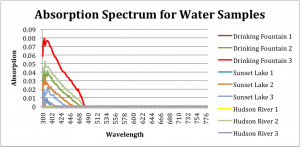Results and Discussion:
Water Contaminant Concentration Tests
| Hudson River | Sunset Lake | Drinking Fountain | |
| Copper (Mg/L) | 0 | 0 | 0 |
| Nitrate (Mg/L) | 5 | 0 | 0 |
Unfortunately, we were unable to deduce anything about the water chemistry from our analysis of the water samples using a spectrometer –much less the concentration of contaminants! The tests using the aquarium water sampling kits failed to demonstrate that either the Hudson River or Sunset Lake was not potable. The EPA water quality standard for nitrates is 10 mg/L, well below what we saw in the Hudson River. We were surprised to see that the Sunset Lake sample registered no nitrates. The New York government website states that a level of 3 mg/L is expected in any body of water where there is a significant human presence. We suspect this is due to the quality of our testing kit, which is only accurate to 5mg/L. So, does this mean the water in Sunset Lake and the Hudson River is potable? Absolutely not! Though our data does not allow us to conclude our water samples were not potable, we were able to test for only two of the over eighty contaminants listed on the EPA website.
Though we did not find any evidence in our results, our group performed further research to confirm our initial hypothesis that the Hudson River near Poughkeepsie was not potable. We found a USGS report on water quality in the Hudson River Basin that showed lead, chromium, and zinc were found in higher concentrations than deemed safe for drinking water in Hudson River water samples taken from a site near Poughkeepsie. Furthermore, we found a report published by the environmental organization Riverkeeper that showed that over 10% of water samples taken from the Hudson River near Poughkeepsie contained an unacceptable concentration of Enterococcus bacteria.
We were unable to find similar studies about the water quality of Sunset Lake. As stated above, our results do not confirm that the water from Sunset Lake is safe for human consumption. Further testing is needed to determine whether or not the water is potable. It is our opinion that future tests should focus on the presence of microorganisms, as they are much easier to detect than small concentrations of chemical contaminants.
